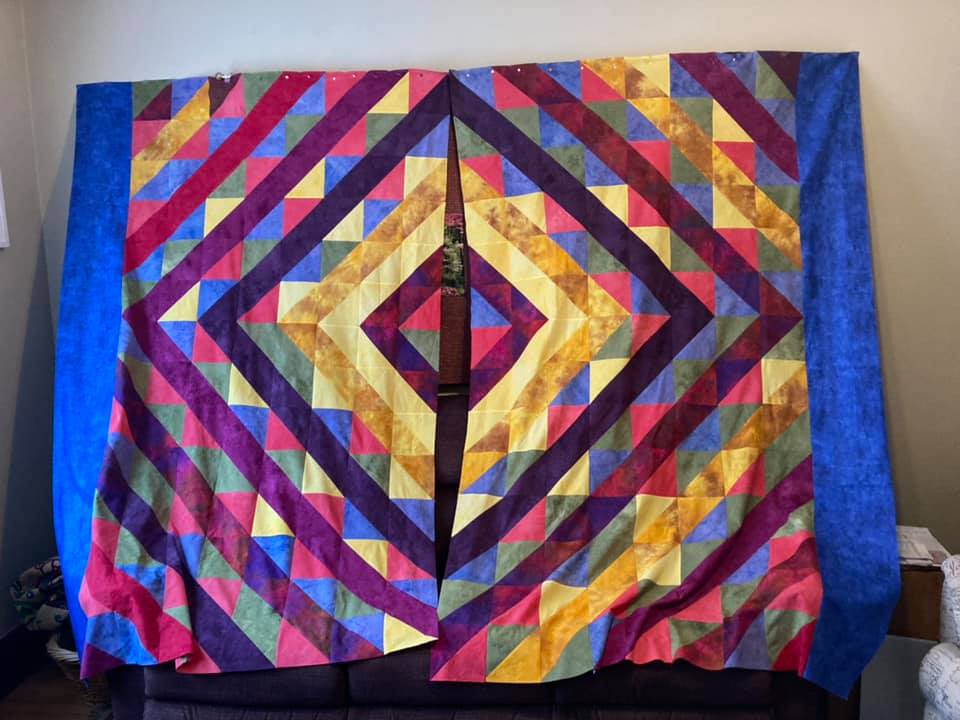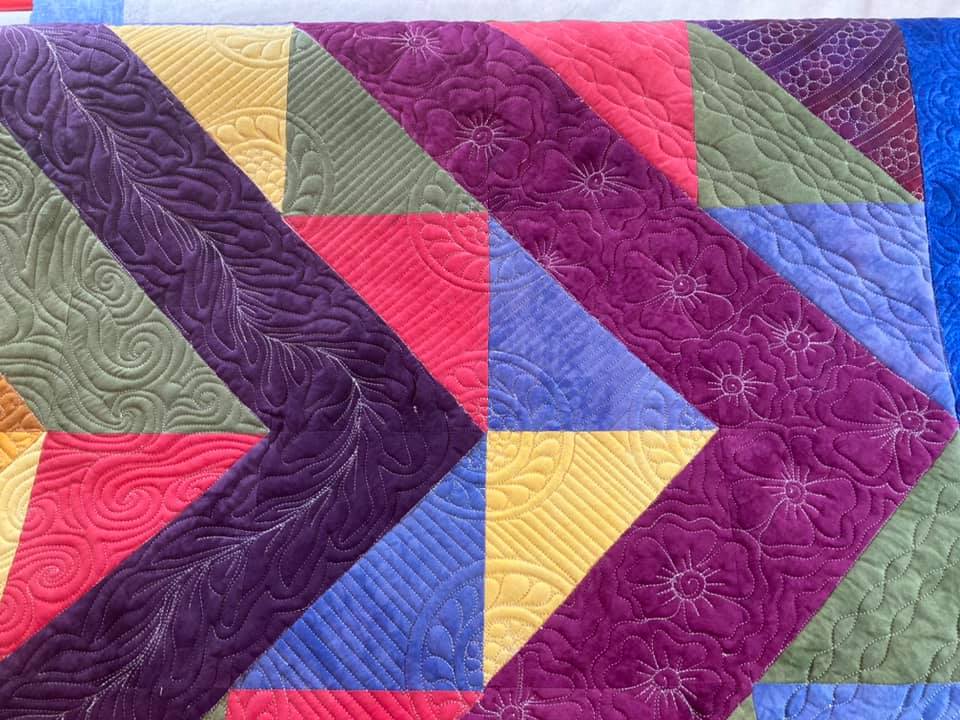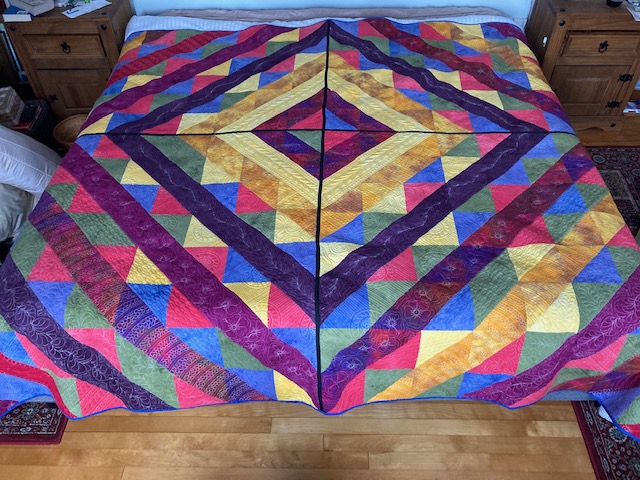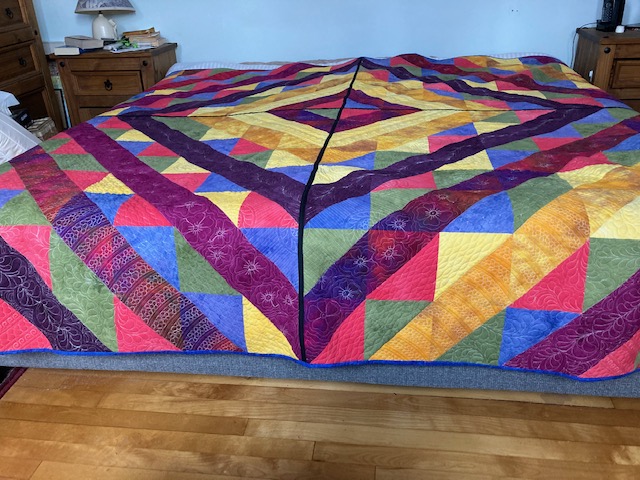At the end of November, I decided to make a new quilt for our bed. Four years ago, I made a lovely one that I call Marijke’s Garden. We had a queen size bed and I made it wider than usual because that way my husband and I both had a good amount of quilt to snuggle under.
We’ve since upgraded to a king size and because I made the garden quilt so wide, it still worked. But then my husband commented that he’d like to have a warmer quilt in the winter. Marijke’s Garden has a cotton/poly batting, so although it is warm, it’s not winter warm. So the challenge was on. To make a king size quilt that I liked, was a bit of a challenge, and warm.
HS Triangle Trip Around the World
I picked a rather traditional scrappy type of pattern and put my own spin on it. The pattern I chose was the Half Square Triangle Trip Around The World. Often they are scrappy quilts, but I chose to use a more uniform theme.
I was looking for a quilt pattern that I could do in two parts, two halves. I have an 8 ft frame, which doesn’t accommodate such a large quilt. And while I did quilt a king on it before (video here), I wasn’t really in the mood to try that again, so I figured I would do it in two parts and then join as a quilt-as-you go sort of thing.
A couple of years ago, I was fortunate enough to take part in Ricky Tims’s Luminarium. It’s a two-day quilting workshop/symposium. With it came Ricky’s store. He had lots of products including some gorgeous hand-dyed fabrics. I bought some. Ok, I bought a lot. But it was so soft to the touch and the colours were fantastic.

When I got home, I wasn’t sure what I wanted to do with them, but they did require a special quilt. This was it.
Preparing for the Quilt
The first step was dividing the fabrics into light and dark values. This wasn’t easy because one fabric seemed like a dark value when beside a lighter one, but then it morphed into a light value when put beside a darker one – so I had to fudge a little.
To make my squares, I used this technique:
I cut out a square from two fabrics, let’s say you use a 12” square. Right sides together, sew all sides with your quarter inch seam. Take the square to your cutting board and cut diagonally across twice, in an X shape. You are left with four pieces. Open them up and press them. There you go, you have four half square triangles. Keep doing this until you have enough for your quilt. Jennie at Missouri Star Quilting Company has a great video on how to do this for this quilt.

I then trimmed all my half square triangles to the right size and got to work designing the quilt.
Let’s Talk About Design Walls
Design walls are a wonderful thing to have. For many years, I laid out my squares on the floor or on my bed, but nothing beats being able to stand back and really look at a quilt in progress. There are several ways to make a design wall, some portable. You just need to Google them.
I did end up buying a portable design wall, but it’s big so I only pull it out when I really need it. For this quilt, I needed it.
For a good while, I just used a cheap vinyl tablecloth I bought at the Dollar Store. In fact, I still use it sometimes for small projects, because I can hang it over the edge of the closet door in my sewing room. I also have some hidden nails in the hall so I can attach the “design wall” that way too if I want. Just be sure to put the vinyl part to the wall because it’s the fleecy part you want to stick your fabric to.
Designing the Quilt
So, after cutting out all those squares, I began placing them in a pleasing-to-me pattern. My big design wall wasn’t big enough for a king, but I was able to get started and look at what I wanted to do. After a lot of fiddling and moving pieces around, I had my design.
People who know me well know I’m not fond of the colour yellow, so they were surprised to see a good bit of it in this quilt. Although yellow isn’t my favourite, I knew that it would look good here.
Putting it Together
Now was crunch time. Time to start sewing it all together.
This took several days because I had to make sure all the rows were sewn together in the right order. I’ve been known to mess that step up – more than once.
I did each column, one by one from the side to the middle. I pinned each block together down the column, brought the column to my machine and sewed them all together. Then I did the next one and sewed both columns together.
To keep track of which end was up and to ensure that I didn’t sew the wrong column to the wrong edge, I used numbers on pieces of paper I’d pinned at the top of each column. If the paper was on the block, that was the top.
I didn’t have quite enough of the right colours to make it wide enough with the half square triangles, so I added a lovely blue Northcott fabric for side borders. I also used it for the backing.
Eventually, all the columns were sewn together and I had two halves of a quilt. I was thrilled. I really liked how it looked.
Now, the Quilting
The next stage is trying to decide how you’re going to quilt your creation. I had recently taken a machine quilting course (can also be used for longarm) offered by Rachelle Denneny, a quilter in Australia. I took her Quilted Wedge Sampler Online Course. Worth. Every. Cent.
I knew that I wanted to use some of these designs in my quilt. I already knew how to do some of them, but I also learned a ton.
So, I set about quilting each diagonal row with a different design. I rarely quilt so densely. I prefer a looser, softer quilting pattern, but this quilt called for it. I used two layers of batting, Hobbs 80/20 on the bottom and a wool batting on top. I wanted the quilt to be warm (a winter quilt) and I wanted the quilting to shine. And shine it did.
I used a soft yellow, Glide thread, Chiffon, for the half square triangles and a matching blue Glide thread for the blue borders.
And here it is!
I used almost a whole cone of Glide thread. In fact, if I hadn’t used blue for the side borders, I may have used all the chiffon colour. There are 5,500 yards of thread on the cone.

If you’d like to see how I put the two halves together, here is a video I made of the process. Please remember that this was my way – and I was learning as I went along. You may have seen or heard of a different way to do this, but I wanted to share my journey as I made my special winter quilt.





















